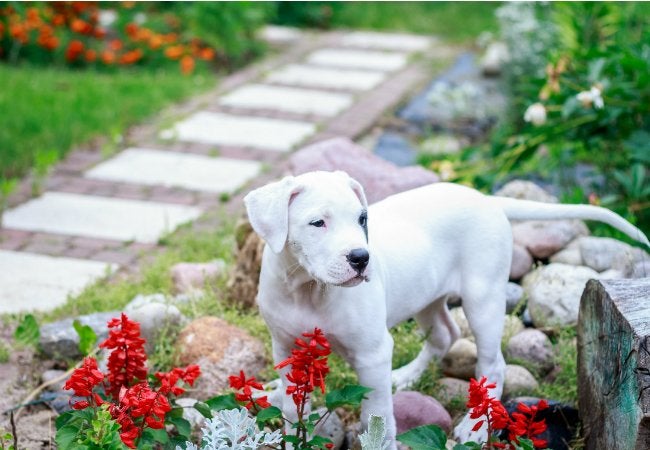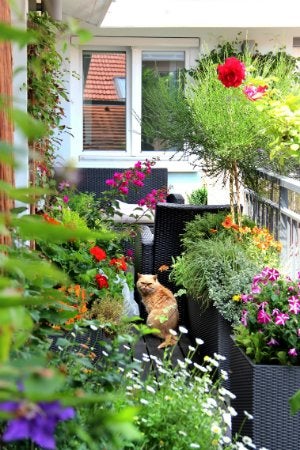Pet-Proof Your Yard with a Dog Trainer's Top 5 Tips
 Photo: fotosearch.com
Photo: fotosearch.comThe great outdoors is great for everyone, particularly your four-pawed pals. The home can get boring for pets, says trainer extraordinaire and Animal Planet starVictoria Stilwell, so being outside is important for both physical exercise and stimulation of the senses, which lends emotional stability.But with the fresh air also comes the potential for those cold, wet noses to get into trouble. Left alone, your lawn could endanger your furry friendor your pet might undo hours of yard work. Avoid these issues and more when you follow Stilwells five key guidelines to creating a fun, safe animal Eden that will always look groomed, even if youve got the friskiest pet on the block.
1. Install the best boundary.
To ensure that animal companions wont get lost or run off, the right yard enclosure is crucial. For canines, Stilwell approves of any good, solid fence, be it wood, metal, vinyl, whatever. But as a big believer that kindnessnot dominanceis the key to positive pet parenting (hence her website, Positively.com), she vehemently opposes invisible electric fences for the pain and anxiety they cause. Even a single shock can rewire a dogs brain, she explains, making him fearful or aggressive.
Because cats are such skillful climbers, corralling them gets trickier. Roller bar attachments that jut out a bit on top of your fence work well, says Stilwell, whereas other fence-toppers like spikes or wire netting (which a cat could get tangled in) may inadvertently wound your animal. Stilwells favorite option: sturdy kitty enclosures, either ready-made or assembled from a DIY kit. Just make sure yours is long enough to offer some running space, high enough to hold a cat tree, and walled with feline-safe screens.
 Photo: fotosearch.com
Photo: fotosearch.com2. Plant with pets in mind.
Sturdy vegetation with soft foliageartemisia, canna, and lilac, to name a fewwill stand up to roughhousing. But stay away from azalea, rhododendron, foxglove, and lily of the valley, which are all unsafe for an animal to digest. Stilwell also notes that grass should be for rolling in, not munching on. Some varieties can be difficult to digest, she explains. While catnip is indeed a healthy habit for felines, she knows of no canine equivalent. Some trainers use anise because dogs like the smell, but I dont see them going crazy for it, she says.

But its not just the plants toxicity you should worry about when planning your landscape; also watch what you spread around in the garden. Cocoa Mulch, a by-product of chocolate, contains theobromine, a compound toxic to cats and dogsand its sweet smell can be irresistible, Stilwell warns. Once, we took our Chihuahua to a neighbors home, and he ate the pellets they used to get rid of gophers! The little guy is fine, thanks to emergency medical care, but Stilwell now knows to ask friends about potential yard hazards before bringing her pups for a visit.
3. Minimize messes.
Pets are naturally inquisitive, so to keep them from wreaking havoc among your flowerbeds, dont leave them up to their own devices, Stilwell says. Her go-to for occupying any pooch is a treat-packed Kong toy (available on Amazon), as long as you monitor him lest the toy roll somewhere youd rather he didnt romp. Got a digger on your hands? Consider installing a sandpit where he can burrow to his hearts content. Above all, Stilwell says, Play with your pets! Thats the number one way to bond with them while supervising their behavior.
On a more delicate note, should you hope to prevent pets from doing their business on your turf, Walk your dog and be sure he goes before letting him in the yard, Stilwell suggests. Likewise, cats should use the litter box prior to an outing. Stilwell concedes that some animals tend to mark their territory, even after theyve been neutered, as the behavior is habitual as well as biological. Try a sculptural piece of driftwood to serve as a marking post-cum-lawn ornament.
4. Watch out for wildlife.
Dogs and cats are natural predators, and, even though weve bred the desire to kill out of dogs, theyre still predisposed to chasing, Stilwell explains. Pets could get hurt tussling with a raccoon, squirrel, even a possum, while hawks and owls could potentially take off with your little buddy. You cant count on vaccinations to protect against everything, she adds. To safeguard Rufus and Roxy, have them stay inside at dawn, dusk, and overnight, when most wildlife feeds. And on the flip side, keep kitty from littering the lawn with songbirds by trying the clownish, brightly colored anti-predation collars made by Birdsbesafe.
5. Be a good neighbor.
Its not just you and your pets on the planet. Not everyone likes cats or dogs, and you must respect that even if you dont understand itespecially in regard to their property, Stilwell says. Letting pets roam loose is reckless and irresponsible, not to mention against the law. If a pet does happen into a neighbors garden, respond calmly and clean up promptly.
Barking is another large concern, especially as its one of the worst noise pollutants in a neighborhood. A dog that barks relentlessly is either bored, lonely, or hungry, so its negligent to leave him chained up outside unattended. If your dog is barking, see to him immediatelyand if a neighbor practices poor pet ownership in that regard, alert your block association, the police, or animal control.
http://www.bobvila.com/articles/puppy-proofing-your-yard/